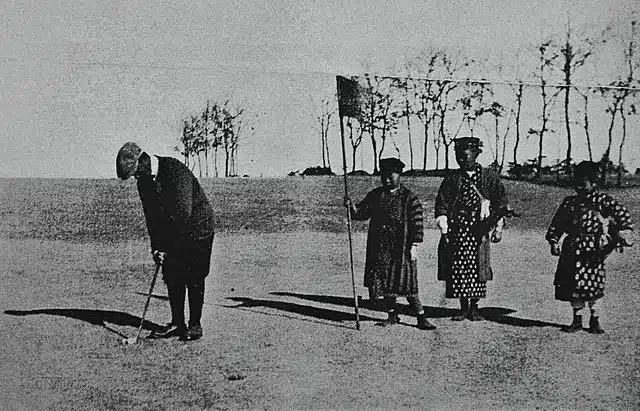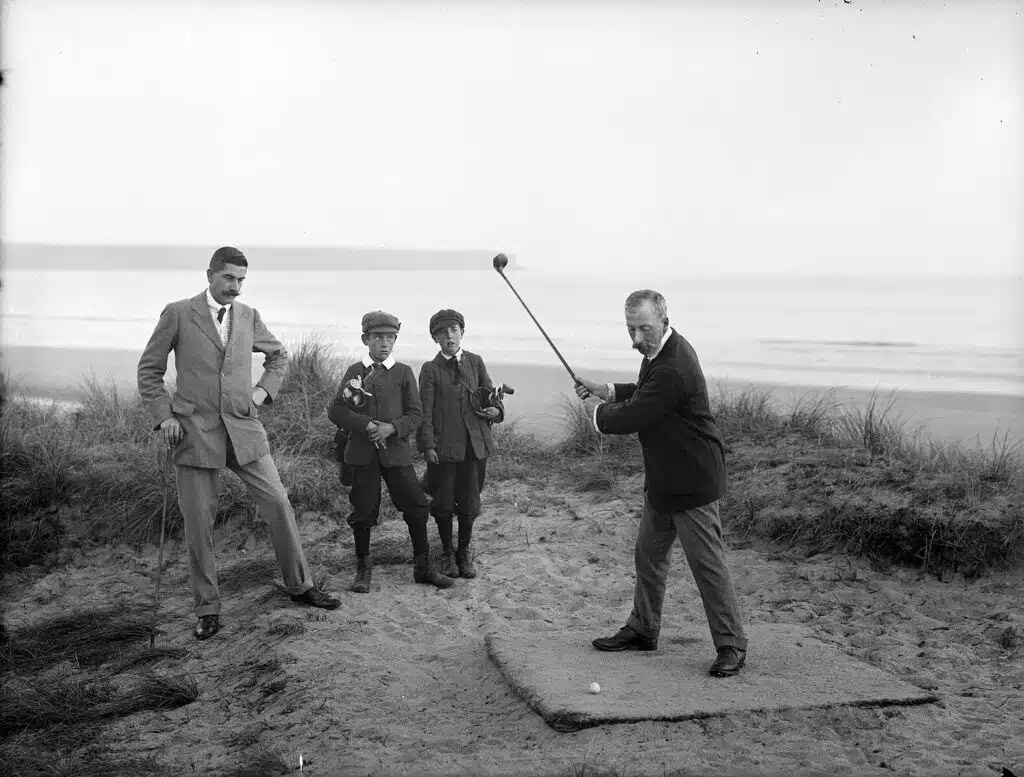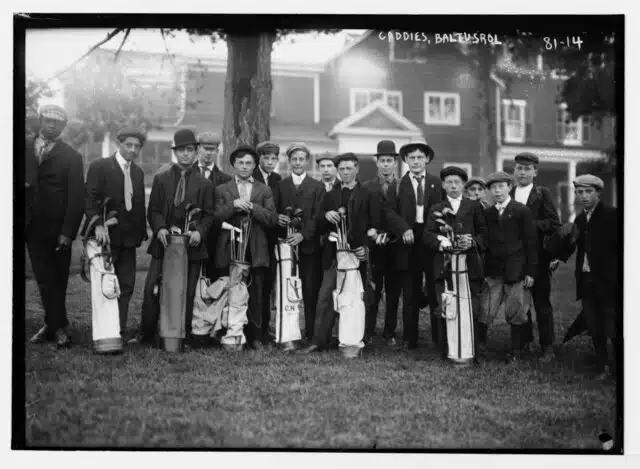To become a caddy, you must not only master the mechanics of golf but also build a professional network, and more.
Here’s how to become a caddy:
- Master Course Management
- Volunteer
- Get Certified
- Network
- Apply for Professional Caddy Jobs
- Continuing Learning
That’s right, it’s not as simple as just submitting a resume.
I’ve employed many caddies in my day, so I am happy to report that this job is fantastic — if you know what you’re doing.
Here are the 7 steps you can start today to get a job as a professional caddy. This isn’t just a general list. I’ll share specifics and online classes to set you apart in the application process.
Below, I’ll cover the skills you can work on, the average salary, and tips from PGA Tour caddies to help you succeed.
How To Become A Professional Caddy
Before I cover the 6 steps, here are the prerequisites to becoming a pro caddy:
- Passion: Most caddies don’t make much money, so you should love spending full days on the course.
- Knowledge: You should know rules, strategy, and course management better than most golfers.
- Skill: You’re probably a great golfer as well. Some PGA caddies have a Tour card themselves. For instance, Joe Greiner plays in the USGA tournaments and also caddies for Max Homa.
- Fitness: You will carry a golf bag weighing 25-35 pounds for ~5 hours daily. Plus, walking over 6 miles for one round.
- Communication: You must be able to share your advice and tips quickly, and — often, you’ll be under pressure.
Now that I’ve covered the basics, are you still in? If so, here are the steps to making money as a caddy.
Step 1: Master Course Management
As a golf caddy, you can offer strategy and on-course decisions that fit your golfer’s playing style. Your advice can make or break your golfer.
If you’re good at this, you will be indispensable and more easily find work. You can prove your prowess by maintaining a low and official USGA handicap; this tells employers you know your way around a golf course.
You probably are better than most now, but so are the other would-be-caddies you compete with. How can you take your current experience to the next level?
Start with a book called Think Like a Caddy, Play Like a Pro. It’s the closest thing to a caddy encyclopedia as it includes information shared by all the best caddies past and present.
Step 2: Volunteer
Caddying can open a lot of doors if you’re dedicated. Try volunteering at a local course if you’re having trouble breaking through.
I’ve hired some of the best caddies I’ve ever had in the parking lot of a golf course. You can also go through dedicated programs. One program will even offer a scholarship for younger aspiring caddies who want a formal education.
To get more experience, volunteer at professional events. This gives you a behind-the-scenes look at what successful caddies do from start to finish. The LPGA is the easiest route to take, and they have events all throughout the US.
Step 3: Get Certified
A certification is not required to become a caddy, but it can set you apart. I’ve never checked for credentials when hiring, but I would’ve been impressed if they were presented to me. Check out the certification from a reputable caddy training program like the International Caddy Certification Program.
This program covers all the caddy-specific details that you may never have thought of as a golfer. The training and lessons are all geared toward a final exam, which, if you pass, you can proudly add to your resume.
Many golf associations, such as the United States Golf Association (USGA), offer training and certification programs for caddies. These programs cover club selection, course management, and overall caddy responsibilities.
Step 4: Network
Networking is crucial to enter the world of professional caddying. Build relationships with golfers, club owners, and other caddies to increase your chances of getting hired. Some of the best golfer/caddy duos are friends like Rory and Harry.
Attend golf events, tournaments, and courses to meet new people and showcase your skills and knowledge. Building a good reputation and strong connections can open up opportunities for you to work with professional golfers.
Step 5: Apply for Professional Caddy Jobs
You can apply for professional caddy jobs once you gain the necessary skills and experience. You can find employment opportunities through job postings at golf courses or by contacting tour managers and professionals directly. Some caddy associations and organizations also offer job listings on their websites.
Step 6: Continue Learning and Improving
Professional golf caddies continually learn and improve their skills. Make a point to keep up with the latest trends, technologies, and tips in caddying and golfing to stay ahead of the competition. Attend online seminars, workshops, and training programs to enhance your skills and gain new insights.
Average Salary for Professional Golf Caddies
The average salary of a golf course caddy is between $50 to $200 per round of golf. They also receive tips from the golfer they are caddying for. The amount of tips can vary greatly, but it’s my experience that a $100 tip for 18 holes is customary.
Of course, this depends on a few factors, such as location, experience, and the type of club or course they work at. Expensive country clubs usually pay more.
Experience also plays a major role in a caddy’s salary, tip, and bonus. They can demand higher fees from their golfers as they gain more experience and knowledge of the course.
And let’s not forget that some caddies also receive benefits such as free meals, access to the club’s facilities, and even transportation to and from the golf course. These perks can make a caddy’s job even more fulfilling and financially rewarding.
PGA Tour caddies usually make around $5,000 for the week no matter what, but the big money comes with their 10% share of any winnings their golfer earns. Caddies for professional golfers like Rory McIlroy can make thousands of dollars in just one tournament — if their golfer performs well.
But the riches don’t stop there. Caddies can also receive bonuses for exceptional service or if their golfer wins a tournament.
Read more: Who is Will Zalatoris’ Caddie and how much does he make?
Tips To Becoming A Caddy From Seasoned Caddies & Coaches
“Anticipate the player’s needs and be prepared.”
Legendary golfer Jack Nicklaus emphasizes the importance of anticipating what the player may need during the round and being ready to assist them immediately.
“Develop a close relationship with the player.”
Caddie Steve Williams, who worked for Tiger Woods for over a decade, stresses the importance of building a solid relationship with the player and understanding their personality and playing style.
“Stay focused and pay attention to the course.”
Professional caddie Michael Greller, who currently caddies for Jordan Spieth, advises caddies to stay focused and always be aware of the course conditions and any potential obstacles.
Skills Needed To Become A Caddy
To make steps 3, 4, and 5 easier, use these tips to expedite your learning process.
- Aside from technical skills, a caddy must possess a deep understanding of the rules of golf. Use a book like “Fast Guide to the Rules of Golf” for easy reference and some nighttime reading. This helps the golfer avoid any penalties or rule infringements.
- A caddy must have a strong grasp of golfer psychology. They must be able to read the golfer’s mood, body language, and temperament to anticipate their needs.
- A professional caddy takes on the role of a strategist. They must be able to assess the golfer’s strengths and weaknesses and develop a game plan for each hole.
- A caddy is responsible for taking care of the golfer’s equipment. This includes cleaning clubs, replacing divots, and repairing ball marks on the green. They must also ensure that the golfer has all the necessary equipment in their bag, such as tees, balls, and a rangefinder.
What Do Professional Golf Caddies Do?
A caddy’s primary responsibility is to assist the golfer in navigating the course and making strategic decisions. This includes providing yardage information, club selection advice, and helping the golfer read the greens.
A caddy must thoroughly understand the course layout, hazards, and wind conditions to provide accurate yardage information to the golfer. They must also have a keen eye for reading the slope and speed of the greens to help the golfer make the best possible putt.canva
One of the best examples of a caddy’s impact on a golfer’s performance is the partnership between Tiger Woods and his former caddy, Steve Williams. Williams stood by Woods’ side for over a decade, giving him valuable insights and meticulous preparation before each round.
In the 2006 Open Championship, Williams famously suggested that Woods hit a 2-iron on the 18th hole, despite Woods initially wanting to hit a driver. Williams’ advice proved crucial, and Woods won the tournament.
FAQ
What is the Difference Between a Golf Caddy and a Forecaddie?
A golf caddy is a much more involved position because of all the duties and responsibilities they are responsible for. A forecaddie is employed to locate your shots explicitly. They are positioned ahead of you to watch your shots and track them down so that you won’t have to look for your ball at all when you arrive at your shot.
Clint is PGA-certified and was a Head Teaching Professional at one of Toronto's busiest golf academies. He was also featured on Canada's National Golf TV program, "Score Golf Canada," twice. He graduated with a degree in Golf Management from the College of the Desert in California and studied under Callaway's co-founder, Tony Manzoni.
He has a handicap index of 6.2 and spends the winters near Oaxaca, Mexico, where he plays twice a month at the Club de Golf Vista Hermosa. He's written over 100 articles at GolfSpan since 2021. You can connect with Clint at LinkedIn, FB, his website, or Clintcpga@gmail.com.
- Best score: 68
- Favorite club: Odyssey White Hot Two-Ball Center-Shafted Putter
- Favorite ball: Titleist Pro V1x
- Favorite food at the turn: Hot dog













